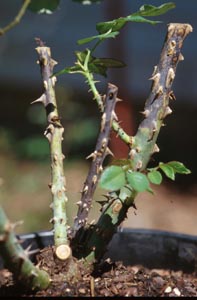
Canker showing on several canes of a potted rose.
CAUSAL ORGANISM: Coniothyrium spp.
After a long cold wet winter, roses can be expected to have some dead and cankered canes. While these pathogenic fungi are not very sophisticated, they can cause considerable damage. The problems can be especially acute on old established roses that have lost some vigor and on young bare root roses emerging from cold storage.
SYMPTOMS: In early spring, pruned stems provide wound sites which can be colonized by canker causing fungi. The stems will yellow, often have red spots and later become brown or black. Black erumpent spots can often be found in the discolored tissue which are the fruiting structures of the fungus containing spores.

Canker showing on several canes of a potted rose.

Canker on stem.
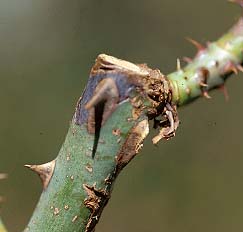
Canker on stem.
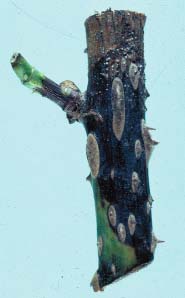
Canker on stem.
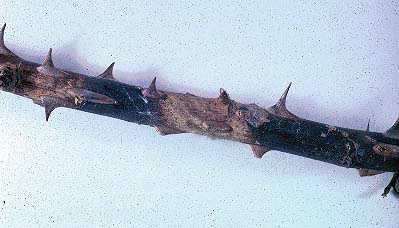
Canker on stem. (Photo provided by Tim Tidwell, CDFA, Plant Pathology Laboratory, Plant Pests Diagnostics Center, Sacramento, CA)
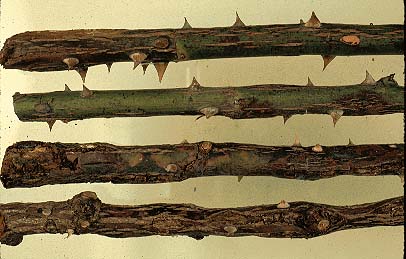
Canker on stem. (Photo provided by Tim Tidwell, CDFA, Plant Pathology Laboratory, Plant Pests Diagnostics Center, Sacramento, CA)
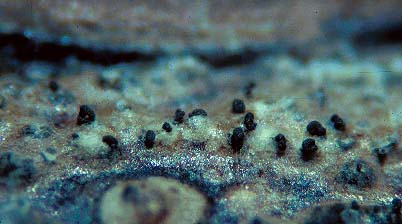
Closeup of fruiting structures containing spores. (Photo provided by Tim Tidwell, CDFA, Plant Pathology Laboratory, Plant Pests Diagnostics Center, Sacramento, CA)
DISEASE CYCLE: The canker fungus is most active during the cold time of the year when roses are not actively growing. Pruning cuts or wounds on stems provide sites of entry for germinating spores. The fungi are not high level pathogens and can not produce the disease when conditions are favorable for plant growth. During the dormant months, fungi colonize the tissues, sporulate and are spread to other pruning or wound sites. The disease can be extensive and severe under the ideal conditions for development.
CONTROL: Promoting vigorous growth and removal of dead canes and stubs will help to reduce the primary source of inoculum. When pruning before winter always make an angular cut close to an active bud so the callus can form a protective layer before winter. A dormant spray could be used to protect pruning cuts and wounds during the cold and wet winter. In spring, removal of infected canes and a general spray program for fungal diseases should reduce canker problems and protect the plants until they can become vigorous growers once again.
Horst, R. K. 1983. Compendium of Rose Diseases. The American Phytopathological Society, St. Paul, Minnesota. Pp 14-17.
![]()
If you have any questions or constructive comments, I would love to hear from you, please send e-mail to Baldo Villegas
[Home]
[Rose Pests Master List]
[Rose Diseases]
[Insect, Mites, and other Animal Pests]
[Abiotic Rose Problems]
[Weed Pests]
[Hawaii Pests]
[The Good Guys]
[Help! Rose IPM]
[Horticulure Links]
Copyright© 1995-2005 by Baldo Villegas
Last updated:
Wednesday, October 26, 2005 10:19 PM